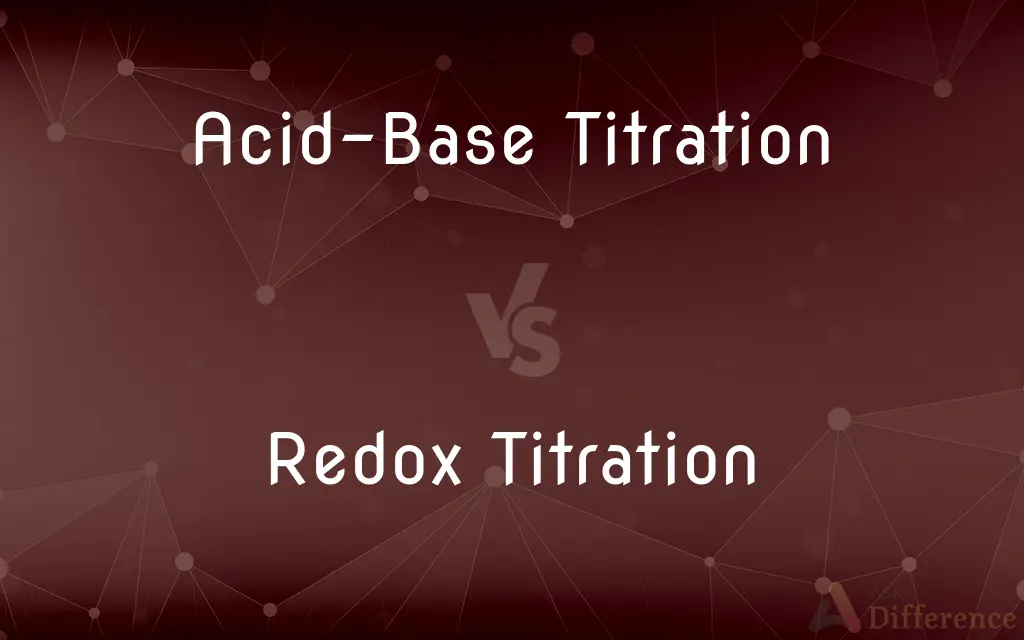Acid-Base Titration vs. Redox Titration — What's the Difference?
By Tayyaba Rehman — Published on November 28, 2023
Acid-Base Titration involves neutralization between an acid and a base, while Redox Titration revolves around a reduction-oxidation reaction.

Difference Between Acid-Base Titration and Redox Titration
Table of Contents
ADVERTISEMENT
Key Differences
Acid-Base Titration is a procedure where an acid reacts with a base to determine its concentration. In contrast, Redox Titration focuses on the transfer of electrons between two reactants, helping to ascertain the concentration of an unknown oxidizing or reducing agent.
In Acid-Base Titration, the endpoint is usually marked by a color change in an indicator, signifying the neutralization of the acid and base. Redox Titration, on the other hand, often involves a change in potential that can be measured with a voltmeter, corresponding to the point where the oxidizing and reducing agents have reacted completely.
Acid-Base Titration plays a pivotal role in laboratories, often used to determine the pH or pOH of a solution. Redox Titration, however, is employed to study substances that act as oxidizing or reducing agents, thus offering insights into redox reactions and the behavior of electrons.
Whereas Acid-Base Titration mainly deals with protons (H+ ions) and hydroxide ions (OH-), Redox Titration encompasses the movement of electrons, leading to changes in oxidation states of the reacting species.
To sum it up, Acid-Base Titration gauges the concentration of acidic or basic substances through neutralization. Simultaneously, Redox Titration delves into the realm of electron transfers, providing vital data on the concentrations of oxidizing and reducing agents.
ADVERTISEMENT
Comparison Chart
Reaction Type
Neutralization
Reduction-Oxidation
Indicators Used
PH indicators (e.g., phenolphthalein)
Potentiometric methods or redox indicators
Involvement of Ions/Electrons
Protons (H+ ions) and hydroxide ions (OH-)
Electrons
Purpose
Determine concentration of acids or bases
Determine concentration of oxidizing or reducing agents
Common Usage
PH determination, acid or base strength
Oxidation state determination, electron transfer study
Compare with Definitions
Acid-Base Titration
Helps in assessing the pH of a solution.
The Acid-Base Titration experiment revealed the pH of the river water sample.
Redox Titration
Involves transfer of electrons in reactions.
In Redox Titration, the substance is either reduced or oxidized to its corresponding state.
Acid-Base Titration
Uses pH indicators to signal completion.
For our Acid-Base Titration, we opted for phenolphthalein as our indicator.
Redox Titration
Gives insights into redox reactions.
The Redox Titration data furthered our understanding of the behavior of electrons in reactions.
Acid-Base Titration
A technique used in laboratories for analytical chemistry.
Students practiced Acid-Base Titration techniques in their chemistry lab session.
Redox Titration
Often employs potentiometric methods.
We used a voltmeter during the Redox Titration to detect the endpoint accurately.
Acid-Base Titration
A method to determine acid or base concentration.
We used Acid-Base Titration to find the unknown concentration of the hydrochloric acid solution.
Redox Titration
Useful in studying electron transfer processes.
Redox Titration is fundamental in studying the characteristics of battery materials.
Acid-Base Titration
Involves neutralization between acid and base.
During the Acid-Base Titration, the solution turned pink, indicating the end point.
Redox Titration
A method to determine the concentration of an oxidizing or reducing agent.
Redox Titration helped us ascertain the concentration of the unknown potassium permanganate solution.
Common Curiosities
How does Redox Titration work?
Redox Titration determines the concentration of an unknown oxidizing or reducing agent by causing a redox reaction with a known counterpart.
Why is an indicator used in Acid-Base Titration?
An indicator in Acid-Base Titration signals the endpoint by changing color when the reaction is complete.
How is the endpoint determined in Redox Titration?
In Redox Titration, the endpoint can be determined using potentiometric methods or by observing a color change in a redox indicator.
Are Acid-Base Titration and Redox Titration performed similarly?
While both involve adding a known solution to an unknown solution until an endpoint is reached, the reactions and indicators used differ.
What's an example of a common indicator in Acid-Base Titration?
Phenolphthalein is a common indicator in Acid-Base Titration.
Can I use any acid or base in Acid-Base Titration?
It's essential to use a strong acid/base with a known concentration to titrate against a weak base/acid for accurate results.
What is Acid-Base Titration?
Acid-Base Titration is a method to determine the concentration of an acid or base by neutralizing it with a base or acid of known concentration.
Which titration method is used for pH determination?
Acid-Base Titration is typically used for pH determination.
Can Redox Titration be used to determine metal ion concentrations?
Yes, Redox Titration can determine metal ions concentrations if they undergo redox reactions.
Is Redox Titration used for electron study?
Yes, Redox Titration provides insights into electron transfer processes.
How is Redox Titration relevant to real-life applications?
Redox Titration is crucial in industries like pharmaceuticals, water treatment, and battery manufacturing.
What is neutralization in the context of Acid-Base Titration?
Neutralization in Acid-Base Titration refers to the complete reaction of an acid with a base, forming water and salt.
Why is it important to know the endpoint in titrations?
The endpoint indicates when the reaction is complete, allowing for the calculation of the unknown concentration.
Share Your Discovery

Previous Comparison
Cell Membrane vs. Plasma Membrane
Next Comparison
Village Life vs. City LifeAuthor Spotlight
Written by
Tayyaba RehmanTayyaba Rehman is a distinguished writer, currently serving as a primary contributor to askdifference.com. As a researcher in semantics and etymology, Tayyaba's passion for the complexity of languages and their distinctions has found a perfect home on the platform. Tayyaba delves into the intricacies of language, distinguishing between commonly confused words and phrases, thereby providing clarity for readers worldwide.
















































